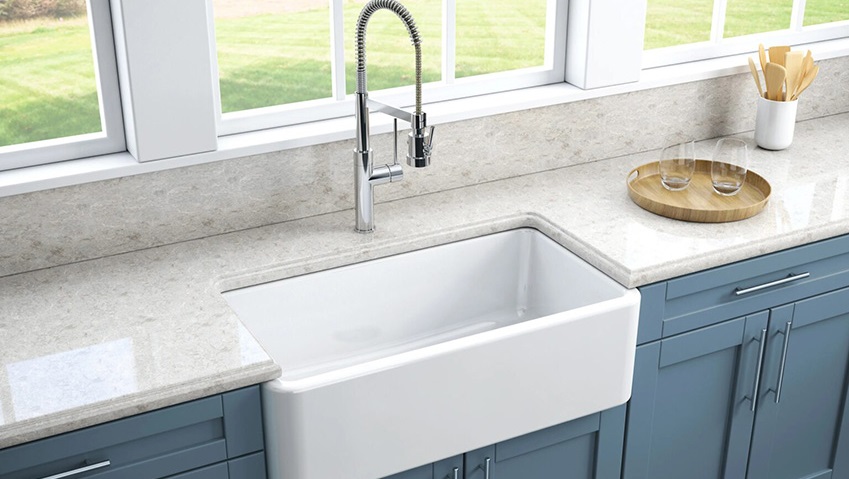
With various materials, sizes, and configurations available for a kitchen sink, making the right choice can be overwhelming. Let us provide valuable tips to help you choose the perfect kitchen sink for your home.
Page Content
Consider Your Kitchen’s Layout
Start by assessing your kitchen’s layout. The size and shape of your kitchen will dictate the size and type of sink that will fit comfortably. A larger kitchen may accommodate a spacious double-bowl sink, while a smaller kitchen may benefit from a single-bowl sink or even a compact bar sink for added versatility.
Sink Material Matters
Kitchen sinks come in various materials, each with unique benefits and aesthetics. Standard options include stainless steel, granite composite, porcelain, and fireclay. Stainless steel is durable and easy to clean, while granite composite sinks offer a contemporary look. Porcelain and fireclay sinks provide a traditional charm. Choose a material that aligns with your kitchen’s style and maintenance preferences.
Think About Configuration
Kitchen sinks are available in different configurations, including single-bowl, double-bowl, and even triple-bowl designs. Consider how you use your kitchen. If you do a lot of multitasking or have a dishwasher, a double-bowl sink can be practical. Single-bowl sinks offer more space for oversized pots and pans. Evaluate your needs to decide on the correct configuration.
Depth and Size Matters
The depth and size of your kitchen sink can significantly impact functionality. Deeper sinks are ideal for soaking and washing large cookware, while shallower sinks may be more comfortable for everyday tasks. The size should also accommodate your most significant pots and pans comfortably.
Mounting Style Options
Kitchen sinks can be top-mounted (or drop-in), under-mounted, or farmhouse-style. Top-mounted sinks are easy to install and offer various design options. Undermounted sinks provide a seamless look with the countertop but require professional installation. Farmhouse sinks, with their exposed front apron, add a rustic touch to kitchens.
Faucet Compatibility
Consider the type and style of faucet you plan to install with your sink. Ensure that your sink has the appropriate number of pre-drilled holes for your faucet and any additional accessories, such as a soap dispenser or a filtered water tap.
Maintenance and Durability
Think about how much time you’re willing to invest in maintaining your sink. Stainless steel sinks are low-maintenance, while porcelain sinks may require more care to prevent chipping and staining. Choose a material that aligns with your cleaning habits.
Budget Considerations
Set a budget for your kitchen sink purchase. While sinks are available at various price points, remember that investing in a high-quality sink can pay off in terms of durability and long-term satisfaction.
Noise Reduction
Some sinks come with noise-reducing features, such as sound-absorbing pads or coatings. If a quieter kitchen is essential, consider sinks designed to minimize noise from running water and dishwashing.
Accessories and Extras
Explore the availability of accessories and extras, such as sink grids, cutting boards, and colanders, that can enhance the functionality of your sink and make meal prep and clean-up more convenient.
End Note
Selection of the right kitchen sink is a significant decision that can impact your daily kitchen routine and the overall aesthetics of your space. By considering layout, material, configuration, size, and budget, you can confidently select a sink that meets your needs and complements your kitchen’s style. Remember that a well-chosen kitchen sink by RAK Ceramics not only enhances functionality but also adds value to your home.

Written by Homer Hoover
Cyclist, hustler, fender owner, hand letterer and growthhacker. Acting at the sweet spot between beauty and sustainability to express ideas through design. I'm fueled by craft beer, hip-hop and tortilla chips.
Recent Posts
- From Palaces to Penthouses: The Evolution of Dubai’s Exclusive Wedding Venues
- How UAE expats can optimise remittances to South Asia: cost-saving tips & regulations
- Hyper-Personalized Pigmentation Maps for the treatment of uneven skin Tone in GCC Residents
- Cultural Bridge: Maestro Mazda And Aesthetics Of Emirates
- The Unique interaction of Traditions and innovation in Teaching: Analytics of English Schools
